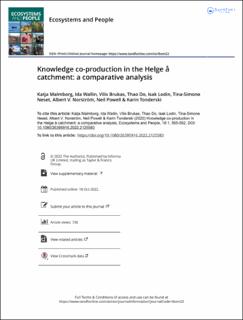| dc.contributor.author | Malmborg, Katja | |
| dc.contributor.author | Wallin, Ida | |
| dc.contributor.author | Brukas, Vilis | |
| dc.contributor.author | Do, Thao | |
| dc.contributor.author | Lodin, Isak | |
| dc.contributor.author | Neset, Tina-Simone | |
| dc.contributor.author | Norström, Albert V. | |
| dc.contributor.author | Powell, Neil | |
| dc.contributor.author | Tonderski, Karin | |
| dc.date.accessioned | 2022-12-22T14:57:11Z | |
| dc.date.available | 2022-12-22T14:57:11Z | |
| dc.date.created | 2022-10-28T15:39:54Z | |
| dc.date.issued | 2022 | |
| dc.identifier.issn | 2639-5908 | |
| dc.identifier.uri | https://hdl.handle.net/11250/3039286 | |
| dc.description.abstract | Addressing sustainability challenges in landscape management requires processes for co-producing usable knowledge together with those who will use that knowledge. Participatory futures methods are powerful tools for attaining such knowledge. The applications of such methods are diverse and understanding the intricacies of the knowledge co-production process is important to further develop these research practices. To improve participatory futures methods and contribute to systematic and critical reflections on methodology, we present a comparative analysis of four research projects that applied participatory futures methods in the same study area. Conducted between 2011 and 2020, these projects aimed to co-produce knowledge about the future provision of ecosystem services in the Helge å catchment area in southern Sweden. For structuring the post-hoc, self-reflexive analysis, we developed a framework dividing the knowledge co-production process into three dimensions: settings, synthesis and diffusion. We based the analysis on documentation from the projects, a two-step questionnaire to each research team, a workshop with co-authors and interviews with key participants. The comparison highlights steps in project decision-making, explicit and implicit assumptions in our respective approaches and how these assumptions informed process design in the projects. Our detailed description of the four knowledge co-production processes points to the importance of flexibility in research design, but also the necessity for researchers and other participants to adapt as the process unfolds. | en_US |
| dc.language.iso | eng | en_US |
| dc.publisher | Taylor & Francis | en_US |
| dc.relation.uri | https://doi.org/10.1080/26395916.2022.2125583 | |
| dc.rights | Navngivelse 4.0 Internasjonal | * |
| dc.rights.uri | http://creativecommons.org/licenses/by/4.0/deed.no | * |
| dc.title | Knowledge co-production in the Helge å catchment: a comparative analysis | en_US |
| dc.type | Journal article | en_US |
| dc.type | Peer reviewed | en_US |
| dc.description.version | publishedVersion | en_US |
| dc.rights.holder | Copyright 2022 the authors | en_US |
| cristin.ispublished | true | |
| cristin.fulltext | original | |
| cristin.qualitycode | 1 | |
| dc.identifier.doi | 10.1080/26395916.2022.2125583 | |
| dc.identifier.cristin | 2066185 | |
| dc.source.journal | Ecosystems and People | en_US |
| dc.source.pagenumber | 565-582 | en_US |
| dc.relation.project | Norges forskningsråd: 12490000 | en_US |
| dc.identifier.citation | Ecosystems and People. 2022, 18 (1), 565-582. | en_US |
| dc.source.volume | 18 | en_US |
| dc.source.issue | 1 | en_US |

